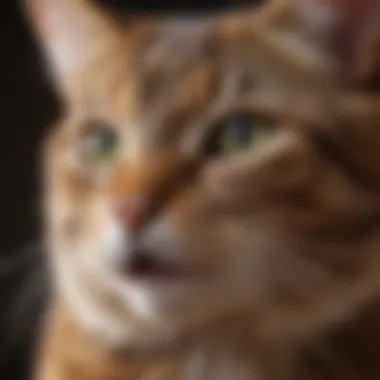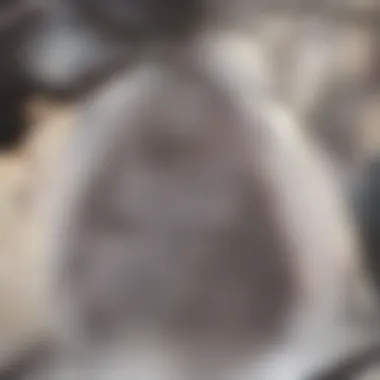FIP Vaccine for Cats: A Pivotal Breakthrough


Intro
Feline Infectious Peritonitis (FIP) is a complex and often fatal disease that affects cats worldwide. Traditional approaches to treating FIP have been largely ineffective, which makes the development of a vaccine a significant advancement in feline medicine. This overview aims to provide a detailed analysis of the FIP vaccine, delving into its mechanism, administration, and implications. Understanding this vaccine not only offers insights for pet owners but also elevates the conversation in the veterinary field regarding the management of FIP.
Key Findings
Major Results
Research into the FIP vaccine has yielded promising findings. Preliminary studies suggest that the vaccine provokes a robust immune response, increasing the likelihood that vaccinated cats will resist the disease. As these studies progress, the clinical evidence continues to support the efficacy of the vaccine in preventing the onset of FIP in genetically predisposed feline populations.
Discussion of Findings
The arrival of this vaccine has reignited discussions within the veterinary community. Prior to this, FIP was considered largely untreatable. The insights from clinical trials indicate that this vaccine could be a game changer. However, the intricacies of FIP itself complicate matters. Further research is necessary to determine the long-term efficacy and safety of this vaccine, as well as its applicability in various cat breeds.
Methodology
Research Design
Current research on the FIP vaccine is primarily observational and experimental. Scientists use controlled environments to monitor the vaccine's effects across varying demographics of cats, including age, breed, and health status.
Data Collection Methods
Data is collected through a combination of serum sampling, immunological assays, and clinical observations post-vaccination. These methods allow for comprehensive insights into both the immediate and long-term outcomes related to the vaccination.
"With these advancements, we are entering a new era for feline health, one where FIP might become a preventable disease."
The future of feline veterinary care hinges on the success of this vaccine. More research is crucial to validate its ongoing effects. As researchers continue to analyze the data, every piece of evidence contributes to a deeper understanding of FIP and its prevention.
Understanding FIP
Feline Infectious Peritonitis (FIP) is a complex disease caused by the feline coronavirus. It is an important topic in veterinary medicine due to its high mortality rate and significant impact on feline health. Understanding the etiology, pathophysiology, and epidemiology of FIP is crucial in developing effective treatment strategies and preventive measures, including vaccination.
Etiology of FIP
The etiology of FIP is linked to the mutation of feline coronavirus, which is ubiquitous among cats. The virus is typically present as a benign enteric form, but under certain circumstances, it can change into a virulent form that leads to FIP. The specific triggers of this mutation are not fully understood. Viriuses can gain access to the immune cells, evading the cat’s defense system. This highlights the importance of early detection and monitoring.
Pathophysiology
In terms of pathophysiology, FIP affects the cat's immune system significantly. In general, the virulent form typically causes a dysregulated immune response. This results in inflammation that is particularly destructive in the abdominal cavity, thoracic cavity, and central nervous system. The chronic inflammation leads to fluid accumulation and various organ dysfunctions, which ultimately contribute to the clinical signs associated with FIP. Affected cats might exhibit symptoms such as fever, weight loss, and abdominal distension.
Epidemiology
Epidemiologically, FIP is more prevalent in multi-cat households or shelters, where stress levels can trigger the disease. Young cats between six months to two years old are notably at higher risk, but adult cats are not entirely immune. The transmission of the feline coronavirus is primarily through fecal-oral routes. Understanding these aspects of FIP can assist veterinarians and pet owners in managing and preventing outbreaks. Particular attention should be paid to environmental cleanliness and the overall health status of the cat population in proximity.
"FIP is not only a veterinary challenge but also a critical concern for cat owners who aim to protect their pets against this serious disease."
Comprehending the multifaceted nature of FIP is essential in appreciating the relevance of the vaccination effort. This knowledge creates informed decisions about preventive care and treatments available in the landscape of feline health.
Overview of Vaccination in Veterinary Medicine
Vaccination plays a critical role in veterinary medicine. It significantly contributes to disease prevention, control, and eradication among animal populations. In the context of the FIP vaccine, understanding vaccination principles is essential for recognizing its potential benefits and limitations. Vaccines can minimize the spread of infectious diseases, reduce veterinary costs, and enhance the overall health of pets, particularly in communities with high-risk feline populations.
Moreover, the development and implementation of vaccines depend on robust scientific research and veterinary practices. This article captures the essence of these principles, ensuring that readers appreciate not just the FIP vaccine itself but how it aligns with established vaccination protocols in veterinary care.
Principles of Vaccination
Vaccination is based on the principle of stimulating the immune system. It allows the body to recognize and mount a response against specific pathogens without causing the disease. Vaccines contain antigens that mimic disease-causing agents. The immune system recognizes these antigens as foreign, activating immune responses, which include the production of antibodies.
The fundamental principles of vaccination involve:
- Antigenic stimulation: Introducing components of the pathogen to induce an immune response.
- Memory formation: Triggering the immune system to develop a memory of the pathogen, enabling a quicker response upon subsequent exposure.
- Herd immunity: Achieving broader protection within a population, with significant implications for controlling diseases like FIP.
The adequacy of these principles largely depends on factors such as the vaccine formulation, route of administration, and timing of vaccinations in accordance with an animal's life stage or health status.


Types of Vaccines
Understanding the types of vaccines is crucial in the context of FIP and other diseases. Generally, vaccines can be categorized into two main types: inactivated (killed) and live attenuated. Each type has specific applications and implications for efficacy and safety.
- Inactivated Vaccines: These vaccines contain dead pathogens incapable of causing disease. They may require multiple doses to achieve adequate immunity since the immune response is generally weaker compared to live vaccines.
- Live Attenuated Vaccines: These contain weakened forms of the pathogen that can still replicate but do not cause the disease in healthy animals. They typically elicit a stronger immune response and often only require a single dose for long-lasting immunity.
In the case of the FIP vaccine, a live attenuated vaccine has been utilized, presenting unique advantages but also considerations regarding safety and potential adverse effects.
Both types of vaccines require careful evaluation during development to ensure they provide benefits without significant risks. This nuanced understanding of vaccination types is essential for both veterinarians and pet owners as they navigate vaccination decisions for feline patients.
Development of the FIP Vaccine
The development of the FIP vaccine signifies a major milestone in feline health management. Feline Infectious Peritonitis has long plagued the veterinary community, leading to significant mortality in infected cats. The advent of a reliable vaccine could transform not only treatment protocols but also improve the overall health outcomes for felines globally. This section provides insight into the research and innovations that have advanced the field, along with a timeline that outlines key events in the vaccine's progress.
Research and Innovations
Research in FIP vaccine development involves various approaches aimed at eliciting robust immunity against the virus. The primary focus has been on understanding the underlying mechanisms of how FIP manifestations occur. Recent advancements in molecular biology have facilitated a more detailed examination of the feline coronavirus. This research has allowed scientists to identify target antigens that could provoke a protective immune response.
Innovative approaches also include the development of modified live vaccines. These vaccines aim to simulate natural infection without causing disease. This type of vaccine prepares the immune system to respond effectively in the case of actual exposure. Notably, ongoing studies are exploring adjuvants that could enhance the efficacy of these vaccines. Such explorations are crucial for increasing the longevity and strength of the immune response, addressing concerns about the durability of protection.
Furthermore, collaboration within the scientific community has accelerated advancements. Multi-disciplinary efforts between veterinarians, virologists, and immunologists have enriched the framework within which FIP vaccine research is conducted. This synergy has fostered innovations that could not have been possible in isolation. It is clear that research and innovation in the field remain crucial for the success of the FIP vaccination program.
Timeline of Development
The timeline of FIP vaccine development illustrates the evolution of scientific discovery in this arena. Here are some significant milestones:
- Mid-20th Century: Initial identification of feline coronavirus as the causal agent of FIP.
- 1980s: Research efforts intensified, focusing on the pathogenesis of FIP, leading to better understanding.
- 1990s: Attempts to create a vaccine met with limited success, primarily due to the complex nature of the virus.
- 2000s: Advances in molecular techniques enabled researchers to develop vaccines that showed promise in eliciting an immune response in laboratory settings.
- 2011: The first vaccine for FIP received conditional approval in some regions, though it was not widely adopted, owing to mixed efficacy reports.
- 2020s: Ongoing research continues to improve the formulations, emphasizing safety and effectiveness.
The progress made in these years reflects the dedication of researchers to combat FIP, but challenges remain. Continuous efforts must be made to ensure that developments align with veterinary practices and public health considerations.
Vaccine development is a dynamic and complex process that requires persistent effort and innovation to adapt to the needs of the feline population.
Mechanism of Action
Understanding the mechanism of action of the FIP vaccine is crucial for appreciating its role in combating Feline Infectious Peritonitis. This section delves into how the vaccine operates within the body to elicit protective responses against the virus responsible for FIP. Knowing the underlying principles helps both veterinary professionals and cat owners comprehend the vaccine's relevance in overall feline health management.
How the Vaccine Works
The FIP vaccine employs a unique approach to stimulate the immune system. Unlike traditional vaccines that often use killed or inactive viruses, this vaccine takes a different route. It uses a modified live virus to provoke a response. This method encourages the cat’s immune system to recognize the FIP virus as a threat. When a cat receives the vaccine, it exposes the body to a harmless form of the virus. This nuanced interaction equips the immune system with the necessary tools to identify and combat the actual virus in the future.
The major elements of how the vaccine achieves its purpose include:
- Antigen Presentation: After vaccination, the modified virus interacts with immune cells, which then present viral antigens to T cells and B cells. This presentation is crucial for both the humoral and cellular immune responses.
- Production of Antibodies: The presence of the viral antigens prompts B cells to produce specific antibodies against them. These antibodies remain in the cat's system and are vital for fending off infections.
- Cell-Mediated Immunity: The vaccine also enhances T cell activity, which helps in recognizing and destroying cells that may become infected by the FIP virus. A well-rounded immune response relies on both antibody production and cellular response.
Immunological Response
Upon vaccination, the immunological response unfolds in several phases. Initially, the active immune engagement occurs at the site of injection. Here, immune cells gather to tackle the modified virus. This marks the start of a chain reaction that leads to comprehensive immunity.
The immunological response can be broken down into key stages:
- Activation Phase: The antigen from the vaccine is recognized by dendritic cells, which migrate to lymph nodes and engage with T cells.
- Proliferation: Activated T and B cells undergo proliferation, creating a substantial pool of specific immune cells and antibodies.
- Differentiation: In this phase, some of the B cells develop into memory B cells. These memory cells are crucial for a faster response during subsequent exposures to the virus.
Ultimately, the immunological response generated by the FIP vaccine not only helps in preventing the disease but also contributes towards building lasting immunity against FIP. This long-term efficacy is what makes understanding the mechanism and the immune system's role so vital.
The effectiveness of the FIP vaccine underscores the importance of eliciting a robust and multi-faceted immune response, which is essential in protecting felines from this serious disease.
Efficacy of the FIP Vaccine
The efficacy of the FIP vaccine represents a crucial aspect of its role in feline health management. A thorough understanding of its effectiveness not only influences veterinary practices but also shapes the decision-making process for pet owners. Evaluating the vaccine’s efficacy involves examining various factors, including clinical trials, field studies, and overall outcomes in feline populations. Each element contributes to a comprehensive picture of the vaccine’s potential benefits and limitations.
Clinical Trials and Results
Clinical trials serve as a cornerstone in the evaluation of the FIP vaccine. These studies are designed to assess both the safety and effectiveness of the vaccine in controlled environments. Trials typically measure how well the vaccine stimulates the immune response in cats at risk for FIP.
In a significant study, conducted by researchers at the University of California, the vaccine was administered to a select group of cats known to be exposed to feline coronavirus. The results showed a marked increase in the production of antibodies. This indicates a robust immunological response, implying that the vaccine can effectively prepare the feline immune system to combat the disease should the cat become exposed to the virus.


Moreover, the clinical outcomes reported favorable results, with vaccinated cats showing a lower incidence of FIP compared to unvaccinated controls. This reduction highlights the vaccine's potential to decrease disease prevalence within susceptible populations. Importantly, these clinical trial results lay the groundwork for further studies in real-world scenarios.
Field Studies
Field studies provide additional insights into the effectiveness of the FIP vaccine outside of controlled trial conditions. These studies assess how the vaccine performs in everyday settings, which often differ significantly from the ideal conditions of clinical trials.
In one notable field study conducted across several veterinary clinics, nearly 500 cats were vaccinated. The data collected over a two-year period demonstrated that the vaccinated group had a notably lower rate of FIP development compared to the unvaccinated group. This substantial evidence suggests a practical benefit of the vaccine in preventing the disease in diverse environments.
Another aspect of these field studies is the observation of demographic variances. Certain breeds, such as Siamese and Burmese cats, are genetically predisposed to FIP. Tracking the vaccine's efficacy in these populations offers critical feedback on its effectiveness across genetic lines, enhancing our understanding of targeted vaccination strategies for at-risk feline groups.
"The FIP vaccine has shown promise both in controlled trials and in real-world applications, suggesting a potential shift in managing this previously devastating disease."
While these findings are encouraging, it is essential to acknowledge that ongoing research is necessary to refine our understanding of the vaccine's long-term efficacy, especially in diverse feline populations. Factors such as age, pre-existing health conditions, and exposure levels to the feline coronavirus complicate assessments of efficacy and warrant further studies to draw definitive conclusions.
The evidence gathered from both clinical trials and field studies establishes a strong foundation for considering the FIP vaccine as an essential tool in feline healthcare. By integrating findings from various study types, veterinarians and researchers can develop more effective vaccination protocols, ultimately aiming to protect the health and well-being of cats everywhere.
Administration of the Vaccination
The administration of the FIP vaccination is a critical component in the control and prevention of Feline Infectious Peritonitis. Understanding how and when to vaccinate can influence the overall health outcomes for cats. With the development of the vaccine, careful attention must be paid to the protocols and post-vaccination care to maximize its efficacy and safety. This section will explore these considerations in detail.
Recommended Protocols
When it comes to administering the FIP vaccine, following recommended protocols is essential. These guidelines are designed to ensure not only the effectiveness of the vaccine but also the safety of the feline population.
- Age of Vaccination: Cats should typically be vaccinated between 16 and 20 weeks of age. Early administration may not elicit the desired immune response, while delayed vaccination may increase the risk of exposure.
- Initial Vaccination Series: The initial vaccination often requires two doses, administered three to four weeks apart. This helps to build adequate immunity.
- Booster Shots: Annual booster shots are recommended to reinforce immunity, especially in high-risk environments such as multi-cat households or shelters.
- Health Assessment: Before vaccination, a thorough veterinary examination is vital. This ensures that the cat is healthy and ready for vaccination without underlying conditions that could lead to adverse reactions.
- Record Keeping: Maintain precise records of each vaccination, including dates, lot numbers, and administering veterinarian. This is not only useful for future care but also necessary for compliance with any regulations.
Post-vaccination Care
Once the FIP vaccine is administered, proper post-vaccination care is crucial to monitor the cat's health and ensure a positive response to the vaccine. Here are essential elements of post-vaccination care:
- Observation: After vaccination, observe the cat for at least 30 minutes for any immediate adverse reactions, such as swelling or difficulty breathing. quick intervention is important if any severe symptoms arise.
- Hydration and Nutrition: Ensure that the cat has access to fresh water and nutritious food after vaccination. This can help in recovery and maintain strength.
- Restricted Activity: Limit vigorous activities for a few days post-vaccination. This aids in preventing stress on the immune system while it works to build resistance against FIP.
- Monitor Symptoms: It is essential to monitor for any signs of adverse reactions over the next week. Common mild symptoms can include lethargy, slight fever, or soreness at the injection site. If these symptoms persist or worsen, consulting a veterinarian is recommended.
- Follow-up Appointments: Schedule a follow-up visit to discuss the cat's health and assess any possible side effects or reactions to the vaccine. This is also an opportunity to stay updated on any additional recommendations from the veterinary community.
"Recognizing the importance of vaccination protocols and post-care enhances the overall effectiveness of the FIP vaccine and safeguards feline health."
The administration of a vaccine is not merely a routine procedure. It necessitates a well-considered strategy that intertwines vaccination protocols and attentive care. This integration reinforces the importance of vaccination as a proactive measure against Feline Infectious Peritonitis.
Safety Considerations
In the context of the FIP vaccine for cats, safety considerations are paramount. Understanding the safety profile of the vaccine can help pet owners and veterinary professionals make informed decisions. Safety evaluations assure that the benefits of vaccination outweigh potential risks, providing a measure of confidence for all involved.
Adverse Reactions
Adverse reactions to vaccines can range from mild to severe. With the FIP vaccine, common mild responses may include:
- Swelling at the injection site
- Mild fever
- Decreased appetite
These reactions usually resolve within a few days without the need for treatment. However, more serious adverse effects, while rare, may occur. These can include:
- Allergic reactions, which could lead to anaphylaxis
- Neurological issues in exceptionally rare instances
Monitoring your cat after vaccination is crucial. Immediate veterinary attention may be necessary if severe reactions are observed. Routine pre-vaccination health checks also form a critical part of ensuring overall safety, as underlying health issues could predispose cats to adverse effects.
"Vaccine safety is integral to fostering trust in vaccination programs and enhancing the overall health of feline populations."
Contraindications
Establishing contraindications is essential for identifying which cats should not receive the FIP vaccine. Certain populations may face heightened risks if vaccinated, including:
- Kittens younger than 16 weeks
- Immunocompromised cats, as the vaccine may not elicit an adequate immune response
- Cats with known allergies to components of the vaccine
Before vaccination, it's vital to conduct a thorough assessment of a cat's health history. This assessment should include any previous adverse reactions to vaccines and the presence of existing health conditions. Clinical judgment plays a significant role in vaccination decisions, and discussions between pet owners and veterinarians can clarify the best course of action for individual cats.
Challenges and Controversies


Skepticism Among Veterinarians
The introduction of the FIP vaccine has led to diverse opinions within the veterinary community. Skepticism exists, mainly due to uncertainties surrounding Feline Infectious Peritonitis itself. Some veterinarians argue that the complexity of FIP, caused by a mutation of feline coronavirus, makes it difficult to effectively vaccinate against. They raise concerns regarding the vaccine's efficacy, duration of immunity, and potential for adverse effects. Clinical experiences also vary significantly. While some practitioners report positive outcomes, others have observed limited effectiveness in certain feline populations.
Additionally, this sentiment can be rooted in a lack of comprehensive clinical trial data. Some veterinarians seek more robust evidence before endorsing widespread vaccination. The fragmented data may stem from the novelty of the vaccine, which complicates consensus-building in the community. It becomes critical to address these concerns transparently to foster trust among veterinarians and pet owners alike.
Public Perception
Public perception of the FIP vaccine is another important element. Many pet owners, motivated by the desire to protect their cats, view the vaccine as a significant advancement. However, misinformation and lack of understanding about FIP contribute to mixed feelings about vaccination. Some cat owners remain skeptical, attributing FIP to misconceptions and misunderstanding its nature. They may wonder if the benefits of vaccination outweigh potential risks, especially when considering adverse reactions.
Education plays a vital role in shaping public perceptions. As awareness increases, more cat owners may become informed about the disease's serious implications and the vaccine's potential benefits. This understanding can drive demand for the product but also raises expectations regarding its effectiveness. Therefore, maintaining transparent communication between veterinarians and pet owners is essential to navigate these challenges.
To address these misconceptions:
- Provide clear information about FIP's nature and the vaccine's role.
- Share case studies and testimonials to demonstrate the vaccine's effects.
- Clarify the importance of early vaccination in high-risk populations.
"Educating the public on FIP and its vaccine is key to fostering trust and making informed decisions."
Thus, a nuanced understanding is crucial, balancing public optimism with realistic expectations. This approach can bridge the gap between veterinary skepticism and public enthusiasm, ensuring the responsible integration of the FIP vaccine into standard veterinary practices.
Future Perspectives
The importance of future perspectives in the context of the FIP vaccine cannot be understated. It encapsulates the ongoing evolution in veterinary medicine and reflects a proactive approach to feline health. Understanding what lies ahead is vital for stakeholders. This includes veterinarians, researchers, and, most importantly, cat owners who seek the best for their pets.
The development of a vaccine against FIP introduces new possibilities for infection prevention. Ongoing research initiatives play a crucial role in exploring the efficacy of the vaccine in various environments and among different cat breeds. These initiatives also focus on improving vaccine formulations and delivery mechanisms, thereby ensuring better immunological responses across the feline population.
Moreover, future studies will investigate the long-term effects of vaccination, examining both the duration of immunity and any potential adverse effects. With these findings, practitioners can make informed decisions about vaccination protocols and schedules.
Ongoing Research Initiatives
Numerous research initiatives are currently underway to broaden our understanding of the FIP vaccine. These studies aim to analyze various aspects of vaccination effectiveness in diverse feline populations. Highlights include:
- Clinical Trials: Ongoing trials focus on the vaccine's performance in different cat demographics, including age, health status, and breed differences.
- Vaccine Formulations: Researchers are testing variations in vaccine compounds to enhance immune responses and minimize side effects. These explorations are essential to establish a universally effective vaccine.
- Field Studies: Observational studies gather data from cat populations post-vaccination. This data helps determine real-world effectiveness and guides future improvements in vaccine strategies.
Such research is essential not just to validate the immediate benefits of the vaccine but also to assess its long-term sustainability and effectiveness in field conditions.
Potential for Widespread Adoption
The potential for widespread adoption of the FIP vaccine hinges on several critical factors. While the vaccine shows promise, broader acceptance depends on multiple considerations:
- Veterinary Training: Enhanced education for veterinarians on the FIP vaccine's benefits and administration will facilitate informed recommendations.
- Public Awareness: Informing pet owners about the dangers of FIP and the vaccine's role in prevention can shift perceptions and cultivate a proactive approach to feline health.
- Policy and Guidelines: Development of standardized vaccination guidelines by veterinary associations may streamline vaccine recommendations, fostering widespread implementation in practices.
Future adoption of the FIP vaccine can significantly reduce the incidence of FIP in feline populations, safeguarding health and prolonging life.
Impact on Feline Health
The development of the FIP vaccine is a significant milestone in the realm of feline healthcare. Feline Infectious Peritonitis (FIP) has long posed a dire threat to cats, causing widespread suffering and mortality. This vaccine represents a proactive approach in addressing this disease, emphasizing its potential to change the landscape of feline health substantially.
The impact on feline health can be analyzed from both a preventative and a therapeutic perspective. For one, the vaccine aims to enhance the overall immunity of cats against FIP, which could lead to a decline in incidence rates. By reducing the number of infected animals, the health of the feline population as a whole can improve, leading to a decrease in healthcare costs associated with treatment and management of FIP.
Moreover, the vaccine promotes a healthier interaction among cats in communal settings, such as shelters or multi-cat households. Increased vaccination can limit the spread of the virus, thus protecting vulnerable populations, such as young kittens and those with pre-existing health conditions.
In summary, the impact of the FIP vaccine on feline health is profound. It not only addresses the challenges posed by FIP but also supports a broader initiative for healthier feline communities.
Long-term Benefits
The long-term benefits of the FIP vaccine extend beyond immediate immunity. One of the most notable advantages is the potential for improved cat longevity. Healthy cats are more likely to live longer lives, which is a primary concern for pet owners. Vaccination can contribute to a significant decrease in the number of cats developing severe forms of FIP, thus enhancing life expectancy.
Additionally, widespread vaccination efforts can lead to herd immunity. When a large portion of a cat population is immunized, the overall risk of outbreak decreases significantly. This is particularly valuable in settings like veterinary clinics, animal shelters, and breeding facilities. Lower rates of infection not only protect individual cats but also significantly reduce the stress and costs associated with managing outbreaks.
Moreover, as more cats receive the vaccine successfully, we may observe a reduction in the economic burden of veterinary care required for FIP. This financial aspect can incentivize more pet owners to keep their cats up-to-date on vaccinations, further aiding in the battle against this disease.
Considerations for Pet Owners
Pet owners should consider several factors when integrating the FIP vaccine into their routine care for cats. Firstly, understanding the nature of FIP and the role that vaccines can play in infection prevention is essential. Not all cats are at equal risk; young kittens, unvaccinated adults, or cats in high-risk environments may require additional attention.
It's also crucial to maintain an open dialogue with veterinarians. Veterinarians can provide guidance on the best vaccination protocols and inform pet owners about any recent findings related to the vaccine's efficacy and safety. Follow-up appointments may be required to assess the need for booster shots, depending on the cat's health status.
Lastly, pet owners should keep a close watch for any adverse reactions post-vaccination. While serious complications are rare, being aware of potential side effects plays a vital role in ensuring that pets receive the utmost care and handling.
Overall, responsible vaccination and active participation in preventive healthcare can lead to a healthier, longer life for our feline friends.



